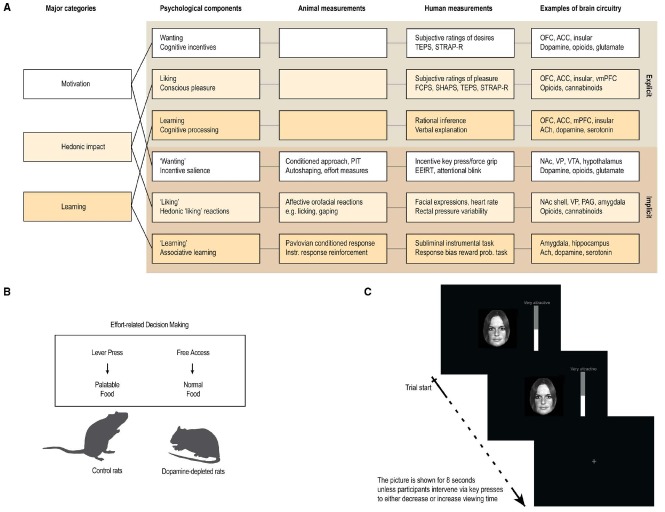FIGURE 1.
Measuring anhedonia. (A) Anhedonia is linked to problems with the complex and multifaceted psychological processes involved in reward processing. These include explicit processes of wanting, liking, and learning that are consciously perceived, and their implicit counterparts (denoted with quotation marks in the text) that are potentially unconscious, i.e., they can operate at a level not always accessible to conscious awareness. These components constantly interact and require careful scientific analysis to tease apart. Animal studies have provided measurements or behavioral procedures that are especially sensitive markers of each of the potentially unconscious processes (“wanting,” “liking,” and “learning”). Recently, some of these procedures have been successfully translated to human studies, thereby providing more objective behavioral measures to aid subjective self-report measures. In particular, recent developments of behavioral measures of “wanting” and “learning” are promising, while bias-free measures of “liking” reactions in humans have proven more difficult. (B,C) Examples of how a measure of “wanting” has been successfully translated from animal to human studies. (B) In animal studies, “wanting” can be measured by looking at how willing the animal is to exert effort in exchange for more palatable food rewards, for example by using a choice paradigm devised to look at effort-based decision-making (Salamone et al., 1994). (C) In human studies, “wanting” can be measured similarly, by looking at how much a participant is willing to work for a reward, for example by combining salient stimuli with key-press/force-grip procedures. The first study of this kind used key-presses to operationalize “wanting” as the effort participants exerted to increase or decrease viewing time of images of salient faces on a screen (Aharon et al., 2001). OFC, orbitofrontal cortex; ACC, anterior cingulate cortex; vmPFC, ventromedial prefrontal cortex; NAc, nucleus accumbens; PAG, periaqueductal gray; VP, ventral pallidum; VTA, ventral tegmental area; ACh, Acetylcholine; PIT, pavlovian instrumental transfer; EEfRT, effort expenditure for rewards task. Figure and figure legend modified and reprinted with permission from Frontiers in Behavioral Neuroscience (Rømer Thomsen et al., 2015).

